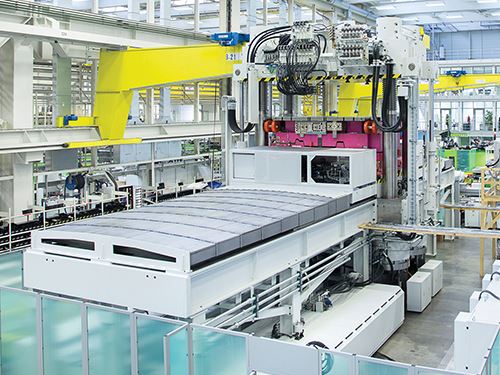Liquid Composites Molding Progresses at BMW and VW
Composites
With lightweighting and fuel efficiency as drivers, two German automakers pursue alternative technologies for structural parts.
With increasing frequency, news reports highlight the automotive industry’s active pursuit of lightweight structural plastics composites for future generations of fuel-efficient vehicles. The latest thrust to emerge in public is development of liquid molding processes, both thermoplastic and thermoset, at two major German automakers, BMW AG and Volkswagen AG.
BMW INVESTS IN HP-RTM
BMW continues its exploration of large composite parts for lightweight automotive structures. It just installed a 3600-metric-ton model of the new vertical v-duo two-platen injection press from Engel Austria (U.S. office in York, Pa.), a smaller version of which was shown at K 2013 in Dusseldorf (see our January show report). The machine was delivered to BMW’s plant in Landshut, Germany, where it will be used to mold large structural elements from continuous-fiber composites using the HP-RTM (high-pressure RTM) process.
This process injects liquid reactive components for thermosets (epoxy or polyurethane) or thermoplastics (caprolactam for in-mold polymerization of nylon 6) over a layup of dry reinforcing mats or fabrics. BMW plans to use the Engel press for thermoset composites, but would not specify the resin system.
The press has two slide tables to remove finished parts and insert fiber reinforcements. Engel notes that the machine has a much smaller weight, footprint, and height than typical vertical compression presses. The clamp unit is accessible from all four sides instead of just two. The press uses ecodrive servo-driven hydraulic pumps for energy efficiency, without any hydraulic accumulators.
VW EXPLORES THERMOPLASTIC RTM
Both Engel and KraussMaffei (U.S. office in Florence, Ky.) are developing equipment systems for thermoplastic RTM, involving conversion of liquid caprolactam monomer into nylon 6. Because of the low-viscosity of molten caprolactam, it can impregnate dry fabric reinforcements in a mold, which would be impossible with viscous nylon in its polymerized state. Engel has pursued what it calls “in situ polymerization” using modified injection machines—either a special twin-barrel horizontal press or the vertical v-duo type mentioned above, which is fed by a Hennecke polyurethane-type metering machine.
KraussMaffei, on the other hand, has pursued what it has dubbed “T-RTM” by means of one of its own PUR metering machines paired with a vertical-clamp, tilting mold carrier (also introduced at K 2013). This equipment comes from the Composites/Surfaces Business Unit of the Reaction Process Machinery Div. at KM (kraussmaffeigroup.us).
The first products made with KM’s T-RTM process are B-pillar reinforcement prototypes made at the FRP TechCenter of the Volkswagen Group Research Center in Wolfsburg, Germany.
The project utilized caprolactam supplied by BASF SE (U.S. office in Wyandotte, Mich.), A special RimStar series metering machine was adapted specifically to the extremely low viscosity of caprolactam and was fitted with a special mixhead, high-performance axial pumps, and a fully electric temperature-control system.
Related Content
-
Automotive Awards Highlight ‘Firsts,’ Emerging Technologies
Annual SPE event recognizes sustainability as a major theme.
-
Atop the Plastics Pyramid
Allegheny Performance Plastics specializes in molding parts from high-temperature resins for demanding applications as part of its mission to take on jobs ‘no one else does.’
-
Impacts of Auto’s Switch to Sustainability
Of all the trends you'll see at NPE2024, this one is BIG. Not only is the auto industry transitioning to electrification but there are concerted efforts to modify the materials used, especially polymers, for interior applications.


















